Why not set timer for an hour before you get up and save all that gas.?We’re not in during the day so why would we want to have the heating on…
I’m maybe missing your point here…
we are manually setting heating OFF during day and then manually set it ON in evening to about 22 and then manually set it to 16 overnight so when we wake up first thing in the morning it isn’t too cold when we get ready for an hour before leaving the house
You are using an out of date browser. It may not display this or other websites correctly.
You should upgrade or use an alternative browser.
You should upgrade or use an alternative browser.
Thermostat behaving abnormally
- Thread starter collinsc
- Start date
Yes great question !Why not set timer for an hour before you get up and save all that gas.?
We have had a problem with the timer element if this thermostat also! Our heating engineer couldn’t work it out either.
Total mess up this system.
- there is no TRV in our bedroom (where we would want it so we could keep that low but have the bathrooms higher for the heated towel rails)
- the down stairs thermostat Also heats upstairs landing AND one of the 3 bedrooms (and the upstairs thermostat does 2 bedrooms and the upstairs bathroom and en-suite)
That worked thanks - I’ll just turn it up a bit more.How is the stat behaving now @collinsc ??.
- Joined
- 27 Jan 2008
- Messages
- 27,493
- Reaction score
- 3,323
- Location
- Llanfair Caereinion, Nr Welshpool
- Country

As to TRVs, I was a big fan, I have 10 programmable TRV heads, but problem is, once novelty has want off, don't look at them much. Downstairs toilet and shower, has the TRV head originally in wife's bedroom, it is Bluetooth so only links to one phone, hers, and she has just not got around to changing the program.
Wi-Fi models, not so bad, google Home brings them all together with on app. But working out what to set them at is something else. Wife's bedroom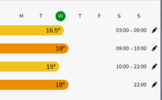 so heats before she retires, and before she gets up, but cooler through the night and through the day, cost me nearly £80 to set that up, with TRV head and signal booster socket, was there a cheaper way, yes she could move to a warmer room. Main living room OK in there most of the day,
so heats before she retires, and before she gets up, but cooler through the night and through the day, cost me nearly £80 to set that up, with TRV head and signal booster socket, was there a cheaper way, yes she could move to a warmer room. Main living room OK in there most of the day,  but, if I look at the actual room temperature,
but, if I look at the actual room temperature, 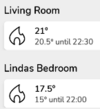 heating not running anyway, patio doors been open most of the day. And the TRVs
heating not running anyway, patio doors been open most of the day. And the TRVs 
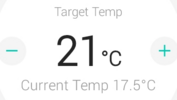 both TRV heads say the room is too cool, but the main thermostat on the wall has not fired boiler, so radiators will not heat up. And I don't want them to heat up, when heating running the thermals in the room mean the air does pass the TRV heads, but being so low down, with patio doors being open, the temperature they show, 20ºC and 17.5ºC are not really the temperature of the room, the 21ºC shown on wall thermometer is more like the real temperature.
both TRV heads say the room is too cool, but the main thermostat on the wall has not fired boiler, so radiators will not heat up. And I don't want them to heat up, when heating running the thermals in the room mean the air does pass the TRV heads, but being so low down, with patio doors being open, the temperature they show, 20ºC and 17.5ºC are not really the temperature of the room, the 21ºC shown on wall thermometer is more like the real temperature.
Heart of winter the TRV heads work well, this time of year, not so good. In real terms, I set them up if cold and down if warm, not really reading the °C being shown. It does depend on furniture, and how well air can circulate. Also on boiler type. But not as straight forward as one may think.
Wi-Fi models, not so bad, google Home brings them all together with on app. But working out what to set them at is something else. Wife's bedroom
 so heats before she retires, and before she gets up, but cooler through the night and through the day, cost me nearly £80 to set that up, with TRV head and signal booster socket, was there a cheaper way, yes she could move to a warmer room. Main living room OK in there most of the day,
so heats before she retires, and before she gets up, but cooler through the night and through the day, cost me nearly £80 to set that up, with TRV head and signal booster socket, was there a cheaper way, yes she could move to a warmer room. Main living room OK in there most of the day,  but, if I look at the actual room temperature,
but, if I look at the actual room temperature,  heating not running anyway, patio doors been open most of the day. And the TRVs
heating not running anyway, patio doors been open most of the day. And the TRVs 
 both TRV heads say the room is too cool, but the main thermostat on the wall has not fired boiler, so radiators will not heat up. And I don't want them to heat up, when heating running the thermals in the room mean the air does pass the TRV heads, but being so low down, with patio doors being open, the temperature they show, 20ºC and 17.5ºC are not really the temperature of the room, the 21ºC shown on wall thermometer is more like the real temperature.
both TRV heads say the room is too cool, but the main thermostat on the wall has not fired boiler, so radiators will not heat up. And I don't want them to heat up, when heating running the thermals in the room mean the air does pass the TRV heads, but being so low down, with patio doors being open, the temperature they show, 20ºC and 17.5ºC are not really the temperature of the room, the 21ºC shown on wall thermometer is more like the real temperature.Heart of winter the TRV heads work well, this time of year, not so good. In real terms, I set them up if cold and down if warm, not really reading the °C being shown. It does depend on furniture, and how well air can circulate. Also on boiler type. But not as straight forward as one may think.
That worked thanks - I’ll just turn it up a bit more.
This controller seems to give the the same problems, ie no boiler request unless the the dT is greater than 1.5C, very strange because my understanding of these controllers is that if the dT is less than 1.5C then the boiler will still fire in short(er) bursts but should still get the temperature up to its setpoint, it looks like the TPI side of these two controllers isn't operating as designed or the minimum firing time of 1 minute isn't sufficient, I would increase this to 2 minutes and see how you get on, also see (even before change) if the boiler is firing for a minute or so when the dT is 1.5C or less.

New thermostat learning shenanigans? Honeywell T3R
About two months ago I replaced old hysteresis type thermostat with T3R, which obviously is not smart but as I understand it, it can take two weeks or so for the stat to settle down (it learns something?) I've programmed certain temps for certain times of day, evening one is an interesting one...
 www.diynot.com
www.diynot.com
- Joined
- 11 Apr 2022
- Messages
- 978
- Reaction score
- 212
- Country

These new TPI thermostats don’t seem like being turned up by less than 1-2c. I have found with my Wiser thermostat that if I want to increase temps by less than 1c the Wiser hub doesn’t react and fire the boiler by up to 15 minutes or so. Presumably the hub needs thinking time!
Interesting, if your Wiser system is talking to a numer of different room "thermostats" then it may not fire atall unless the aggregrate demand is more than 10% with a 1min minimum firing time if you read this regarding a Evohome system, the attached was taken from the Automated Home" site.These new TPI thermostats don’t seem like being turned up by less than 1-2c. I have found with my Wiser thermostat that if I want to increase temps by less than 1c the Wiser hub doesn’t react and fire the boiler by up to 15 minutes or so. Presumably the hub needs thinking time!
"Every HR92 sends a heat demand from 0 to 100% wirelessly to the Evotouch. This is proportional to how much "heat" it thinks it needs from the boiler to reach or maintain the set point. The controller combines the demands of all the different HR92's in some way and forms an aggregate demand also from 0 to 100% which it sends to the boiler relay.
The boiler relay then switches on for this percentage of time in each cycle. So with the default 6 cycles per hour and 1 minute minimum on time a 10% demand is the minimum required to get the boiler to fire at all. A 30% demand would mean 3 minutes on 7 minutes off."
Attachments
- Joined
- 11 Apr 2022
- Messages
- 978
- Reaction score
- 212
- Country

On my Wiser system I now only have a single room thermostat having now removed all the Wiser TRV’s and replaced them with manual TRV’s. I also monitor the Wiser hub with Home Assistant so I can see in detail exactly what happens when a thermostat calls for heat and how the Wiser hub reacts.Interesting, if your Wiser system is talking to a numer of different room "thermostats" then it may not fire atall unless the aggregrate demand is more than 10% with a 1min minimum firing time if you read this regarding a Evohome system, the attached was taken from the Automated Home" site.
"Every HR92 sends a heat demand from 0 to 100% wirelessly to the Evotouch. This is proportional to how much "heat" it thinks it needs from the boiler to reach or maintain the set point. The controller combines the demands of all the different HR92's in some way and forms an aggregate demand also from 0 to 100% which it sends to the boiler relay.
The boiler relay then switches on for this percentage of time in each cycle. So with the default 6 cycles per hour and 1 minute minimum on time a 10% demand is the minimum required to get the boiler to fire at all. A 30% demand would mean 3 minutes on 7 minutes off."
The lowest heating demand I have seen is 20% which equated to a 2min firing of my gas boiler which was not enough time to get any heat into the radiators so I have configured the hub for an oil boiler which results in a minimum 4 minutes firing.
Does a 20% firing demand imply that the dT is 0.3C?, 1.5*20%, and if so, if you left the minimum time at 1 min that eventually the dT would increase to 0.6C and the boiler would then fire for 4 minutes? and a dT of 1.4C (assuming TPI still in control) would demand a 9.3 minute firing time?.
My non TPI controller that fires the boiler directly is set to its minimum hysteresis of 0.3C, but what I notice is that once the room achieves its SP temperature that the controller then demands refiring at a dT of 0.15C (at least its between 0.1C and 0.2C since it only displays one decimal point), it gives excellent control of the combined two rooms its monitoring, I also have conventional TRVs on my other rooms.
My non TPI controller that fires the boiler directly is set to its minimum hysteresis of 0.3C, but what I notice is that once the room achieves its SP temperature that the controller then demands refiring at a dT of 0.15C (at least its between 0.1C and 0.2C since it only displays one decimal point), it gives excellent control of the combined two rooms its monitoring, I also have conventional TRVs on my other rooms.
- Joined
- 11 Apr 2022
- Messages
- 978
- Reaction score
- 212
- Country

The Wiser algorithm is a bit of a mystery to me so I have attached a screenshot from yesterday between 06:00 and 11:00.Does a 20% firing demand imply that the dT is 0.3C?, 1.5*20%, and if so, if you left the minimum time at 1 min that eventually the dT would increase to 0.6C and the boiler would then fire for 4 minutes? and a dT of 1.4C (assuming TPI still in control) would demand a 9.3 minute firing time?.
My non TPI controller that fires the boiler directly is set to its minimum hysteresis of 0.3C, but what I notice is that once the room achieves its SP temperature that the controller then demands refiring at a dT of 0.15C (at least its between 0.1C and 0.2C since it only displays one decimal point), it gives excellent control of the combined two rooms its monitoring, I also have conventional TRVs on my other rooms.
There are 3 graphs, the first is the boiler firing as requested by the Wiser hub, as you can see there are 3 cycles per hour. The second graph shows target and current temperatures, the orange bars are when the thermostat is requesting heat. The thermostat appears to also work in cycles however its is 6 cycles per hour. The third graph shows the heating demand.
Apologies to the OP as this has become a little off topic although there is some relevancy.
Attachments
A single stat, like the EPH below, with either dT control OR TPI control would be a very good choice, IMO. dT control has a adjustable hysteresis of 0.0C to 1.0C and TPI is adjustable between 1.5C and 3.0C, both in 0.1C increments. There is a battery powerd model as well, the HRT, and probably a WIFI version as well.
Attachments
- Joined
- 27 Jan 2008
- Messages
- 27,493
- Reaction score
- 3,323
- Location
- Llanfair Caereinion, Nr Welshpool
- Country

Me as well, but don't know where that screenshot you show came from? Insights? I get thisThe Wiser algorithm is a bit of a mystery to me so I have attached a screenshot from yesterday between 06:00 and 11:00.
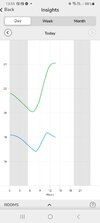 showing two rooms with Wiser thermostats, and how the temperature has been, boiler not running today, but not found anything like this
showing two rooms with Wiser thermostats, and how the temperature has been, boiler not running today, but not found anything like this 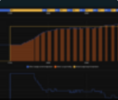 I was a little surprised when I saw:-
I was a little surprised when I saw:-Yes, my single Wiser TRV has taken some getting use to, all others can't call for heat, I could unplug or switch off, the socket adaptor which would stop the Wiser TRV being seen by the hub, but the whole reason for fitting, was so if wife's room too cold, it will fire up the boiler.On my Wiser system I now only have a single room thermostat having now removed all the Wiser TRV’s and replaced them with manual TRV’s.
Mine says App Version 7.0.0 (Build 180592) and my boiler is oil, and does not modulate, but not found any setting to select oil, gas, modulating, non modulating, clear using the OpenTherm connections would tell it using a modulating boiler.
Clearly the 4 or 6 times an hour would not be appropriate for a modulating boiler. Each time the boiler is turned off/on, it starts again, working out how much to modulate. This is the problem I had with this
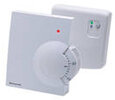 thermostat, it was simply not designed for a modern modulating boiler.
thermostat, it was simply not designed for a modern modulating boiler.I would split the rooms in my house into groups.
1) Used every day for set times, and hours spent in the rooms.
2) Used every day but only for a short time, passing through.
3) Only used for special events, be it the Craft room or Office, only want heating when used.
4) Seldom used, mainly used as a store room.
Also, corridors were, if not heated, heavy drafts when doors opened. And toilets and shower rooms, where even if not there long you want the room heated.
Much comes under, is it worth the expense? If a thermostat in the hall keeps the living room warm, then no need for any linked thermostat in the living room, if the living room has two radiators, is there really any need to link them together? And I have said it many times before, each house is different. And if not broke, don't fix it.
But also, the last thing I want to do, is buy 10 electronic TRV heads, and then realise I need 10 linked electronic TRV heads. Or get a wall thermostat, if a linked TRV head would work better.
I have learnt from getting it wrong. But the big problem is wasting energy. A system may keep the home spot on the temperature required, in other words it works, and as said, if it works, why fix it. However, the gas boiler is the odd one out. It is designed to gain latent heat, my oil boiler just throws it out of the flue, but the gas boiler, at least a modern one, keeps the flue gases cool enough to gain that latent heat. To do this, it needs some different control to the older gas or oil boiler. And this means up/down control, not on/off, the TRV is suited for this analogue control, it slowly reduces or increases flow through the radiators, the boiler measures the return temperature and adjusts output to suit, when the output required is less than the minium output, it initiates a mark/space ratio, switching on/off, but it can't do the final bit, switch off.
So we need a device, which when all rooms are warm, will switch the boiler off, be it linked TRV heads, a wall thermostat, or a special building management package, we need something to turn the boiler off, when all rooms satisfied, and that device could well be the wall thermostat, but with no bells or whistles, just put in the coldest room, to turn off boiler.
So the cleaver mark/space thermostat
 is very good for an old boiler, but will waste energy with a modern one. And my expensive Nest Gen 3 thermostat, for my oil boiler, is no better than the old Honeywell one shown, except I can set a range of temperatures. But the old Honeywell is no good for a modern gas boiler. In the main, looking for a thermostat which connects to the e-bus, be it OpenTherm or some other system.
is very good for an old boiler, but will waste energy with a modern one. And my expensive Nest Gen 3 thermostat, for my oil boiler, is no better than the old Honeywell one shown, except I can set a range of temperatures. But the old Honeywell is no good for a modern gas boiler. In the main, looking for a thermostat which connects to the e-bus, be it OpenTherm or some other system.- Joined
- 11 Apr 2022
- Messages
- 978
- Reaction score
- 212
- Country

@ericmark
The graphs I posted are from Home Assistant, the wiser app is a bit basic in comparison. You can see how the Wiser hub is setup by going into the Wiser Heat app, selecting devices and then selecting the hub.
I removed the Wiser TRV’s to simplify my heating system as I have a pretty conventional house layout with no need to heat rooms individually. I couldn’t see the point of allowing a Wiser TRV’s to activate the boiler just to heat one room.
The graphs I posted are from Home Assistant, the wiser app is a bit basic in comparison. You can see how the Wiser hub is setup by going into the Wiser Heat app, selecting devices and then selecting the hub.
I removed the Wiser TRV’s to simplify my heating system as I have a pretty conventional house layout with no need to heat rooms individually. I couldn’t see the point of allowing a Wiser TRV’s to activate the boiler just to heat one room.
Last edited:
Regarding the issue, I have noticed this morning, that the temperature was set at 18.5 the night before, but was 14.5 this morning! A difference of 4 seems abnormal!
I then set it to 19 to kick it back into action, ran an errand and came home 20 minutes later and it had reached 19 already.
Was trying to upload a video to show this; but wont let me upload.
I then set it to 19 to kick it back into action, ran an errand and came home 20 minutes later and it had reached 19 already.
Was trying to upload a video to show this; but wont let me upload.
Probably time for a new stat, the only strange thing is what I mentioned before where (maybe on the other site you posted on) the set point temp was 17.5C and the indicated room temp was 16C with a boiler (flame) symbol demand displayed on the controller so the boiler should have been firing at this stage, did you notice this morning if the demand symbol was displayed?, if you didn't look for it, maybe check it tomorrow morning and if it is displayed check whether the boiler is firing or not or just firing intermittently.
DIYnot Local
Staff member
If you need to find a tradesperson to get your job done, please try our local search below, or if you are doing it yourself you can find suppliers local to you.
Select the supplier or trade you require, enter your location to begin your search.
Please select a service and enter a location to continue...
Are you a trade or supplier? You can create your listing free at DIYnot Local
Similar threads
- Replies
- 9
- Views
- 2K
- Replies
- 5
- Views
- 1K
- Replies
- 12
- Views
- 2K
- Replies
- 18
- Views
- 2K

